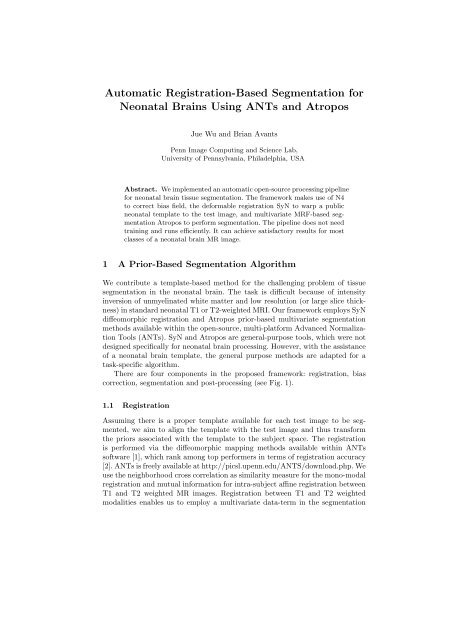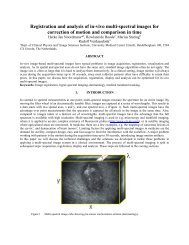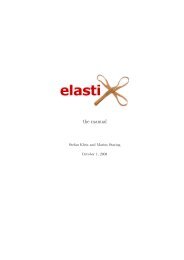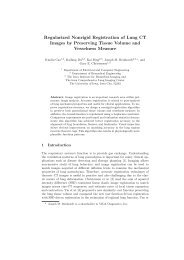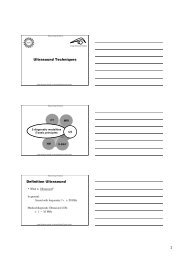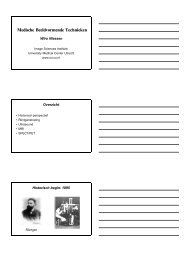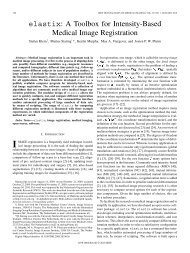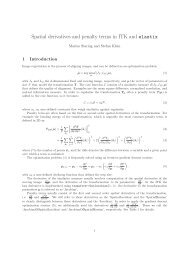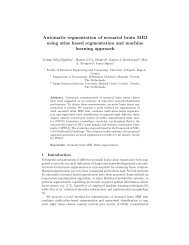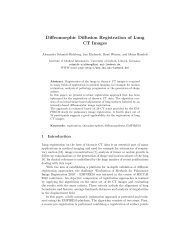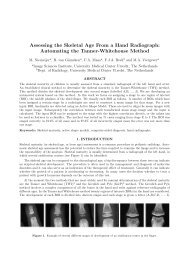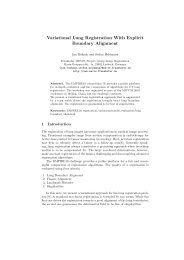Automatic Registration-Based Segmentation for ... - NeoBrainS12
Automatic Registration-Based Segmentation for ... - NeoBrainS12
Automatic Registration-Based Segmentation for ... - NeoBrainS12
You also want an ePaper? Increase the reach of your titles
YUMPU automatically turns print PDFs into web optimized ePapers that Google loves.
<strong>Automatic</strong> <strong>Registration</strong>-<strong>Based</strong> <strong>Segmentation</strong> <strong>for</strong><br />
Neonatal Brains Using ANTs and Atropos<br />
Jue Wu and Brian Avants<br />
Penn Image Computing and Science Lab,<br />
University of Pennsylvania, Philadelphia, USA<br />
Abstract. We implemented an automatic open-source processing pipeline<br />
<strong>for</strong> neonatal brain tissue segmentation. The framework makes use of N4<br />
to correct bias field, the de<strong>for</strong>mable registration SyN to warp a public<br />
neonatal template to the test image, and multivariate MRF-based segmentation<br />
Atropos to per<strong>for</strong>m segmentation. The pipeline does not need<br />
training and runs efficiently. It can achieve satisfactory results <strong>for</strong> most<br />
classes of a neonatal brain MR image.<br />
1 A Prior-<strong>Based</strong> <strong>Segmentation</strong> Algorithm<br />
We contribute a template-based method <strong>for</strong> the challenging problem of tissue<br />
segmentation in the neonatal brain. The task is difficult because of intensity<br />
inversion of unmyelinated white matter and low resolution (or large slice thickness)<br />
in standard neonatal T1 or T2-weighted MRI. Our framework employs SyN<br />
diffeomorphic registration and Atropos prior-based multivariate segmentation<br />
methods available within the open-source, multi-plat<strong>for</strong>m Advanced Normalization<br />
Tools (ANTs). SyN and Atropos are general-purpose tools, which were not<br />
designed specifically <strong>for</strong> neonatal brain processing. However, with the assistance<br />
of a neonatal brain template, the general purpose methods are adapted <strong>for</strong> a<br />
task-specific algorithm.<br />
There are four components in the proposed framework: registration, bias<br />
correction, segmentation and post-processing (see Fig. 1).<br />
1.1 <strong>Registration</strong><br />
Assuming there is a proper template available <strong>for</strong> each test image to be segmented,<br />
we aim to align the template with the test image and thus trans<strong>for</strong>m<br />
the priors associated with the template to the subject space. The registration<br />
is per<strong>for</strong>med via the diffeomorphic mapping methods available within ANTs<br />
software [1], which rank among top per<strong>for</strong>mers in terms of registration accuracy<br />
[2]. ANTs is freely available at http://picsl.upenn.edu/ANTS/download.php. We<br />
use the neighborhood cross correlation as similarity measure <strong>for</strong> the mono-modal<br />
registration and mutual in<strong>for</strong>mation <strong>for</strong> intra-subject affine registration between<br />
T1 and T2 weighted MR images. <strong>Registration</strong> between T1 and T2 weighted<br />
modalities enables us to employ a multivariate data-term in the segmentation
2 Jue Wu and Brian Avants<br />
Fig. 1. Overview of the proposed algorithm<br />
<strong>for</strong>mulation. The brain mask from the template was trans<strong>for</strong>med to subject space<br />
and helped remove non-brain tissues.<br />
The line of code <strong>for</strong> registration between template and test image is:<br />
ANTS 3 -m CC[t2template-GA.nii.gz, test_image.nii.gz, 1, 2]<br />
-r Gauss[3,0] -t SyN[0.25] -i 90x100x80 -o output.nii.gz<br />
1.2 Template Used<br />
To a large extent, the success of prior-based segmentation hinges on the quality<br />
of the chosen template and the similarity between template and test image. We<br />
chose a set of premature neonatal T2 templates from Imperial College London,<br />
which have high definition and good tissue contrast with various post-menstrual<br />
ages. These atlases are based on 204 preterm babies with no observed obvious<br />
pathology and freely available at http://www.brain-development.org/. We<br />
picked two templates, one 30 and the other 40 week old, <strong>for</strong> the current processing.<br />
The original templates have no label <strong>for</strong> myelinated WM and no separated<br />
labels <strong>for</strong> ventricular CSF and extra-cerebral CSF so we created the labels manually<br />
according to the Challenge’s protocol.<br />
1.3 Pre-processing<br />
Pre-processing be<strong>for</strong>e segmentation only involved MR field inhomogeneity correction.<br />
We employed the N4 method [3] to correct bias field and used the probabilistic<br />
map of white matter as a reference. Bias field correction was done <strong>for</strong><br />
independently <strong>for</strong> both T1 and T2 images.
Title Suppressed Due to Excessive Length 3<br />
1.4 <strong>Segmentation</strong><br />
Tissue classification is accomplished by Atropos which uses expectation maximization<br />
to optimize a probabilistic <strong>for</strong>mulation that links a data term with both<br />
spatial and Markov Random Field (MRF) priors. The posterior probability in<br />
the MRF model is composed of the likelihood probability <strong>for</strong> voxel intensity,<br />
prior probability <strong>for</strong> smoothness constraint and template priors. Optimization<br />
is achieved by expectation maximization with an iterated conditional modes parameter<br />
update schema. For technical details about Atropos, readers are referred<br />
to the work of Avants et al. [3]<br />
The Atropos method takes prior probability maps of all tissue classes and<br />
the T2 image (plus the T1 <strong>for</strong> the final iteration) as input. It outputs the segmentation<br />
of all classes as well as probability maps <strong>for</strong> all classes. We restarted<br />
this process three times by setting the output probability maps of the previous<br />
iteration as input probability maps of the next iteration. Due to close intensity<br />
profiles between several tissues (such as cortex and deep gray matter, white matter<br />
and cerebellum, ventricular CSF and extra-cerebral CSF), the tissue priors<br />
were recombined with output probability maps between two iterations to rein<strong>for</strong>ce<br />
spatial constraint. Further details are available in the scripts used <strong>for</strong> this<br />
study which are available from the authors.<br />
The line of code <strong>for</strong> one iteration of prior-based segmentation:<br />
Atropos -d 3 -x mask.nii -c [2,1.e-9] -m [0.10,1x1x1] -u 0 --icm [1,1]<br />
-a test_t1.nii -a test_t2.nii -o [seg.nii.gz,segProb%02d.nii.gz]<br />
-i PriorProbabilityImages[8,prior%02d.nii.gz,0.5] -p Socrates[0]<br />
1.5 Post-processing<br />
The purpose of post-processing is to decrease the number of misclassified voxels<br />
due to unusual intensity of these voxels. The MRF smoothness constraint may<br />
not be able to remove them because they can appear in a cluster. These clusters<br />
can be reduced by reimposing the template-based priors, which are likely to show<br />
low probability of the tissue at this location. There<strong>for</strong>e the misclassification was<br />
replaced with higher probability tissue class.<br />
1.6 Strengths and Limitations<br />
The proposed algorithm has several advantages.<br />
No training is needed. The algorithm only needs a labeled template, where<br />
prior knowledge of tissue distribution is incorporated, and thus training examples<br />
are not necessary.<br />
Relatively fast to run. For each subject, the registration unit takes 40 to 60<br />
minutes depending on the size of the brain. The segmentation part takes about<br />
20 minutes. Bias correction is about 20 minutes and post-processing lasts lest<br />
than 1 minute. The computation was done on a Linux plat<strong>for</strong>m with Intel Xeon<br />
3.2GHz CPU and 2GB memory.
4 Jue Wu and Brian Avants<br />
Open source and public templates. The implementation is based on opensource<br />
softwares and we used templates freely available to the public. There<strong>for</strong>e<br />
the proposed method should have good reproducibility and can be made available<br />
to the public in the future.<br />
One significant limitation of the proposed method is that the extra-cerebral<br />
CSF segmentation is suboptimal due to the fact that the template did not have<br />
features outside of the cerebrum (skull, dura, etc) whereas the test images cover<br />
the whole head. While our registration methodology is fairly robust, in some<br />
cases, this difference may be significant enough to impair registration per<strong>for</strong>mance.<br />
In such cases, the segmentation will also suffer. It is also possible that<br />
neither smoothness prior and template prior can eliminate all misclassification.<br />
Additional anatomical constraints may be helpful, <strong>for</strong> example, WM and extracerebral<br />
CSF voxels cannot be neighbors.<br />
2 Evaluation Results<br />
The snapshots <strong>for</strong> some example segmentation are shown in Fig. 2. The quantitative<br />
evaluation results from the Challenge are shown in Fig. 3, 4 and 5.<br />
Fig. 2. First row is one slice of the first subject from each set (40wk axial, 30wk coronal,<br />
40 wk coronal. Second row is the corresponding segmentation.
Title Suppressed Due to Excessive Length 5<br />
Fig. 3. Quantitative results <strong>for</strong> set1
6 Jue Wu and Brian Avants<br />
Fig. 4. Quantitative results <strong>for</strong> set2
Title Suppressed Due to Excessive Length 7<br />
Fig. 5. Quantitative results <strong>for</strong> set3
8 Jue Wu and Brian Avants<br />
References<br />
1. Avants, B., Epstein, C., Grossman, M., Gee, J.: Symmetric diffeomorphic image<br />
registration with cross-correlation: Evaluating automated labeling of elderly and<br />
neurodegenerative brain. Medical Image Analysis 12 (2008) 26–41<br />
2. Klein, A., Andersson, J., Ardekani, B., Ashburner, J., Avants, B., Chiang, M., Christensen,<br />
G., Collins, D., Gee, J., Hellier, P., Hyun, S., Jenkinson, M., Lepage, C.,<br />
Rueckert, D., Thompson, P., Vercauteren, T., Woods, R., Mann, J., Parsey, R.:<br />
Evaluation of 14 nonlinear de<strong>for</strong>mation algorithms applied to human brain mri registration.<br />
NeuroImage 46 (2009) 786–802<br />
3. Avants, B., Tustison, N., Wu, J., Cook, P., Gee, J.: An open source multivariate<br />
framework <strong>for</strong> n-tissue segmentation evaluation on public data. Neuroin<strong>for</strong>matics 9<br />
(2011) 381–400


